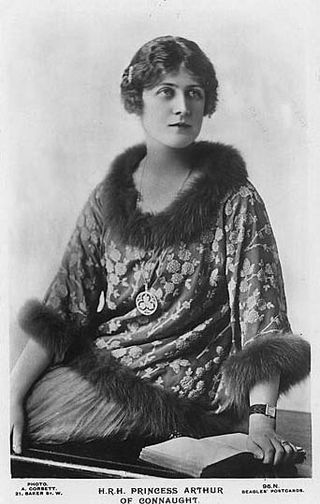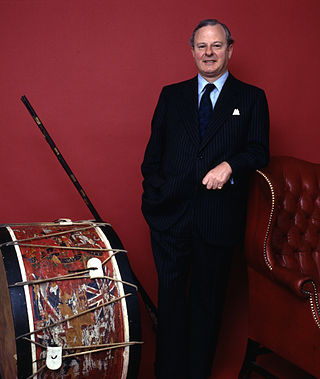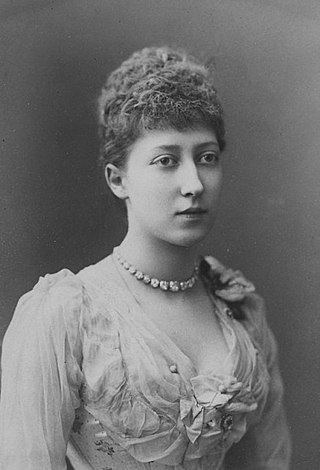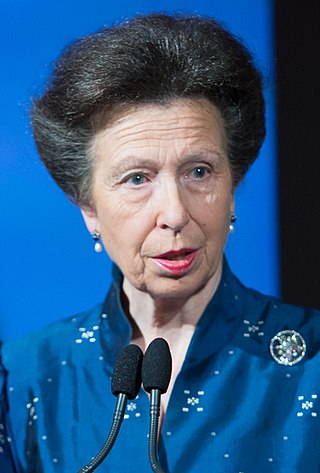
William Cavendish, 5th Duke of Devonshire,, was a British nobleman, aristocrat, and politician. He was the eldest son of William Cavendish, 4th Duke of Devonshire, by his wife, the heiress Lady Charlotte Boyle, suo jure Baroness Clifford, who brought in considerable money and estates to the Cavendish family. He was invited to join the Cabinet on three occasions, but declined each offer. He was Lord High Treasurer of Ireland and Governor of Cork, and Lord Lieutenant of Derbyshire. In 1782, he was made a Knight of the Order of the Garter.

Princess Alexandra, 2nd Duchess of Fife,, born Lady Alexandra Duff and known as Princess Arthur of Connaught after her marriage, was the eldest surviving grandchild of King Edward VII and also the first cousin of George VI. Alexandra and her younger sister, Maud, had the distinction of being the only female-line descendants of a British sovereign officially granted both the title of Princess and the style of Highness.

James George Alexander Bannerman Carnegie, 3rd Duke of Fife was a British landowner, farmer and peer. He was the grandson of Louise, Princess Royal, a daughter of King Edward VII and Queen Alexandra. As a female-line great-grandson of a British sovereign, he did not carry out royal or official duties or receive any funds from the Civil List. He was the second cousin of Queen Elizabeth II and Princess Margaret, Countess of Snowdon, and King Harald V of Norway. Through his maternal grandfather, he was also a descendant of William IV and Dorothea Jordan.

Alastair Arthur Windsor, 2nd Duke of Connaught and Strathearn was a member of the British Royal Family. He was the only child of Prince Arthur of Connaught and Princess Alexandra, 2nd Duchess of Fife. He was a great-grandson of Queen Victoria through his father and the first great-grandchild of Edward VII through his mother. He was also a descendant of Victoria's paternal uncle and predecessor, William IV, through an illegitimate line.

William Douglas-Hamilton, Duke of Hamilton, KG, PC, also known as Lord William Douglas and the Earl of Selkirk, was a Scottish nobleman and politician. He was the eldest son of The 1st Marquess of Douglas by his second wife, Lady Mary Gordon, a daughter of The 1st Marquess of Huntly.

Louise, Princess Royal and Duchess of Fife was the third child and eldest daughter of King Edward VII and Queen Alexandra of the United Kingdom; she was a younger sister of King George V. Louise was given the title of Princess Royal in 1905. Known for her shy and quiet personality, Louise remained a low-key member of the royal family throughout her life.

Alexander William George Duff, 1st Duke of Fife, styled Viscount Macduff between 1857 and 1879 and known as the Earl Fife between 1879 and 1889, was a British peer who married Princess Louise, the third child and eldest daughter of King Edward VII and Queen Alexandra.

Duke of Fife is a title in the Peerage of the United Kingdom that has been created twice, in both cases for Alexander Duff, 1st Duke of Fife and 6th Earl Fife, who in 1889 married Princess Louise, the eldest daughter of Albert Edward, Prince of Wales. The dukedom of Fife was created for a member of the British royal family by marriage, since the first holder's wife was a granddaughter of Queen Victoria.

Earl of Lincoln is a title that has been created eight times in the Peerage of England, most recently in 1572. The title was borne by the Dukes of Newcastle-under-Lyne from 1768 to 1988, until the dukedom became extinct.

Earl of Southesk is a title in the Peerage of Scotland. It was created in 1633 for Sir David Carnegie, an Extraordinary Lord of Session. He had already been created Lord Carnegie of Kinnaird in 1616 and was made Lord Carnegie, of Kinnaird and Leuchars, at the same time he was given the earldom. These titles are also in the Peerage of Scotland. The earldom is named after the River South Esk in Angus. Carnegie's younger brother John Carnegie was given the corresponding title: earl of Northesk. The earl of Southesk also holds the Scottish feudal title of Baron of Kinnaird and is a baronet in the Baronetage of Nova Scotia. Kinnaird Castle, Brechin, has been the home of the earls of Southesk for several hundred years.

The use of the title of Princess of the United Kingdom of Great Britain and Northern Ireland is entirely at the will of the sovereign as expressed in letters patent. Individuals holding the title of princess are styled "Her Royal Highness" (HRH). On 18 April 1917, Frederica of Hanover, the newest granddaughter of Wilhelm II, German Emperor was styled a British princess from birth, even though Germany and Britain were fighting in World War I. Before the First World War, British princesses also held additional German titles, such as princesses of Hanover by virtue of being male-line descendants of George III; or princesses of Saxe-Coburg and Gotha, duchess of Saxony, by virtue of being male-line descendants of Prince Albert of Saxe-Coburg and Gotha. George V issued letters patent on 30 November 1917, to restrict the automatic assignment of the title "princess" and the use of the style "Royal Highness" to the following persons:
The Earl of Fife or Mormaer of Fife was the ruler of the province of Fife in medieval Scotland, which encompassed the modern counties of Fife and Kinross. Due to their royal ancestry, the earls of Fife were the highest ranking nobles in the realm, and had the right to crown the king of Scots.

Isabella Bennet FitzRoy, Duchess of Grafton and later 2nd Countess of Arlingtonsuo jure, was a British peer and heiress.
Suo jure is a Latin phrase, used in English to mean 'in his own right' or 'in her own right'. In most nobility-related contexts, it means 'in her own right', since in those situations the phrase is normally used of women; in practice, especially in England, a man rarely derives any style or title from his wife although this is seen in other countries when a woman is the last heir of her line. It can be used for a male when such male was initially a 'co-lord' with his father or other family member and upon the death of such family member became the sole ruler or holder of the title "in his own right" (alone).
Duchess of Marlborough is a title held by the wives of the Dukes of Marlborough and may refer to:
The Duchess of Hamilton is usually the spouse of the Duke of Hamilton, but in one case is a Duchess of Hamilton in her own right. Duke of Hamilton is an extant title in the Peerage of Scotland which was created in 1643.
Charles Noel Carnegie, 10th Earl of Southesk JP DL, was a Scottish nobleman.
Caroline Maria Graham, Duchess of Montrose was the second wife of James Graham, 3rd Duke of Montrose. She was a daughter of George Montagu, 4th Duke of Manchester, by his wife Elizabeth Dashwood.
John Cochrane, 4th Earl of Dundonald, was a Scottish aristocrat and politician.










